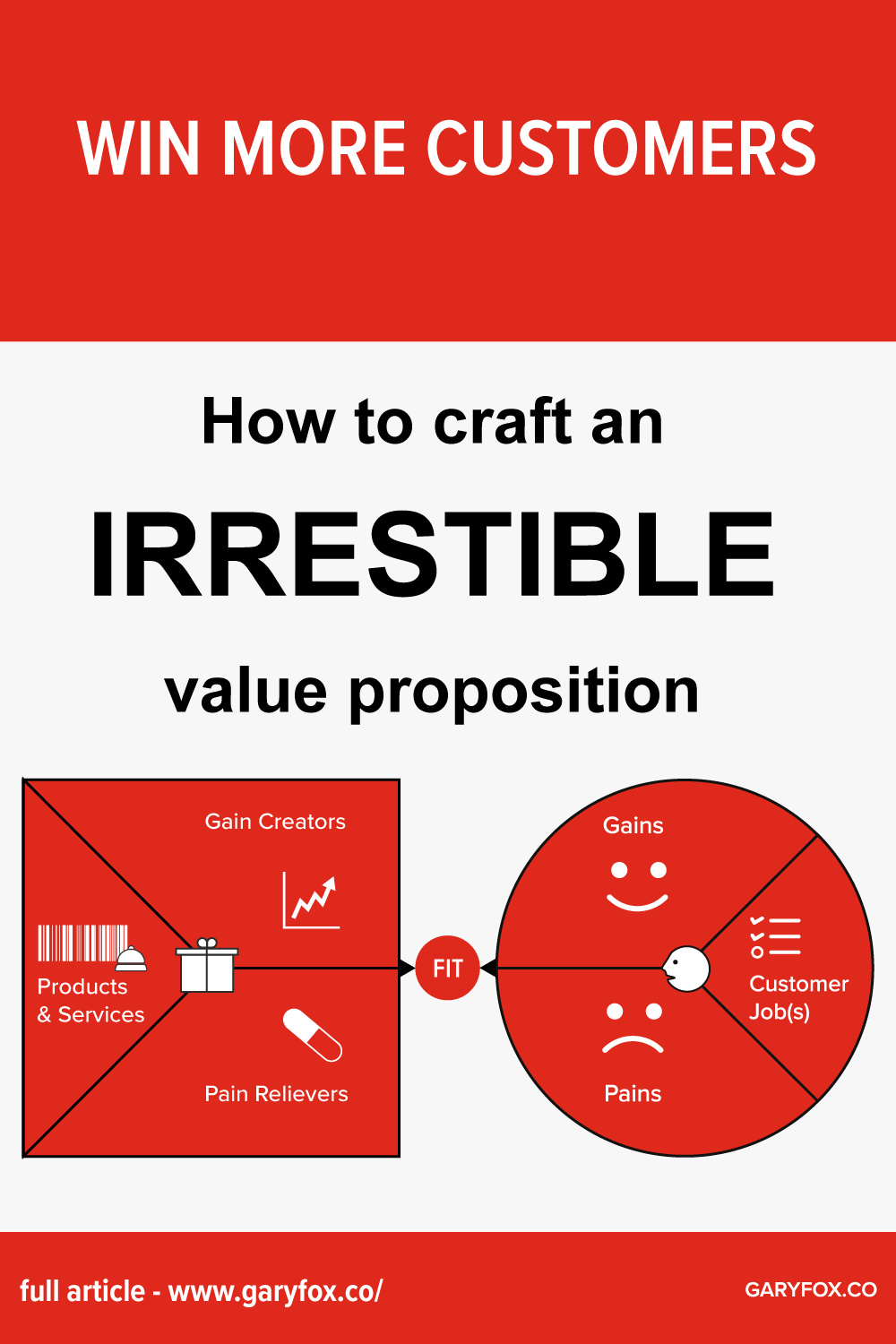If you really care about your customers, really want to understand them, then the value proposition canvas is a tool that will transform how you innovate and market your business.
The Value Proposition Canvas was developed by Alexander Osterwalder and Yves Pigneur to complement the Business Model Canvas. One of the biggest problems when designing a buiness model is how to create value – often people struggle with this.
That’s where the Value Proposition Canvas book comes in. It makes creating a value proposition easier, plus it is packed full of useful tips, advice and resources.
In a nutshell, the value proposition canvas is a transformative approach to understanding value and designing products or services that customers want.
It builds on the inspiring work of the late Clayton Christensen, one of the greatest academics and thought-leaders of our time.
He developed the concept of jobs to be done – which can be found in his book Competing Against Luck. In his words:
Success doesn’t come from understanding the customer. It comes from a deep understanding of the job the customer is trying to get done.
Clayton Christensen
I hope you enjoy the guide, it is full of resources, tips and free pdf templates. Note: The free templates are available at the bottom of the article.
After reading this you will be able to confidently craft value propositions that influence customers to take action.
Table of Contents
What Is the Value Proposition Canvas?
The Value Proposition Canvas was developed by Alexander Osterwalder and Yves Pigneur to complement the Business Model Canvas. The canvas focuses on understanding customers problems and producing products or services that solve them.
Telling people you have a great product doesn’t make them want it.
You can produce an awesome product with all the bells and whistles, but if it fundamentally doesn’t help customers, or you don’t explain the value clearly, they won’t buy it.
In the factory we make products, in the drugstore we sell hope.
Charles Revson – Founder of Revlon
The why is missing? Understanding why customers buy is at the heart of the value proposition canvas.
Free Value Proposition Canvas Downloads
Why Use the Value Proposition Canvas
- According to an article in FastCompany, “Why Most Venture-Backed Companies Fail,” 75 per cent of venture-backed startups fail.
- After four years 56% of small businesses fail.
- 97% of seed or crowdfunded companies eventually die or become “zombies.”
Many of the reasons for these failures can be traced to not understanding the customer and not defining the value – the what’s in it for me – to the customer.
The popularity of the value proposition canvas stems from it now being used by intrapreneurs and entrepreneurs alike. It has become a necessary step in the innovation process.
When you clearly communicate to a customer what you offer you have a far higher chance of them taking action – whether that is signing up, adding a product to cart, buying a product or trialling it.
Ways in which the value proposition canvas will help you to grow your business:
- Customer focus: provide you with a clear process for identifying what a customer is trying to achieve and how the experiences.
- Prioritizes value: the process of developing a value proposition forces you to prioritize what’s important to the customer and select value propositions that have the potential to motivate a customer to take action.
- Provides context: value propositions are often relevant in certain situations and not others. Value changes according to the customer, their situation (e.g. location), why they are trying to get a job done.
- Narrows the Gap: The process improves innovation outcomes and lowers failure rates. It isn’t a magic bullet but it reduces the risks of innovating based on ideas only.
The Quick Guide To The Value Proposition canvas
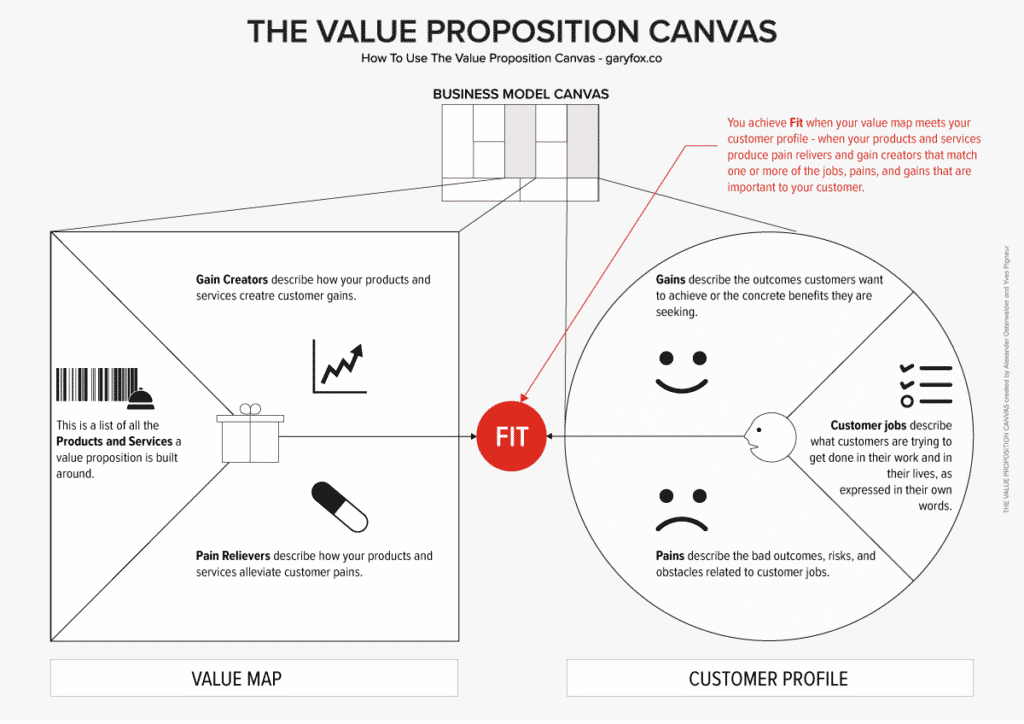
Quick How-To Guide On Creating a Value Proposition
- Choose a customer segment/profile.
- Identify the jobs (see video below) – the things that that the customer is trying to get done.
- Create a list of jobs and prioritize them according to how important they are to your customer.
- Identify your customers’ pains and prioritize them.
- Identify all of their gains and prioritize them.
- Pick top 3-5 pains and gains that are the most important and relevant – that relate to the most important jobs.
- Create a list of all the benefits your product or service offers to your customers.
- Create a list of pain relievers – things that your product can do to alleviate pains.
- Create a list of gain creators – ways in which your product or service creates customer gains.
- Pick the top ones (gain creators and pain relievers) that make the biggest difference to your customer.
- Link the value your products or services create to your customer and choose the most compelling value generators.
- State clearly how your solution is better than the competition.
- Are there any pains or gains that your product doesn’t address?
- Strategically, are these important for you to compete? If yes then begin to innovate – understand how to create the offer.
- Test your value proposition(s) with your customers.
- Create a value statement that is clear and free of jargon. Avoid gimmicky language. You want your customers to believe and trust you.
The Two Sides of the Value Proposition Canvas Explained

Most companies struggle with innovation because those responsible for conceptualizing, developing and evaluating ideas for new product/service offerings struggle with the “needs” side of the equation.
The customer profile is where you reframe your thinking and delve deeply into the ‘jobs’ that customers are trying to get done.
The Customer Profile
The customer profile section of the canvas has three sections:
- Customer Jobs: The things customers are trying to get done in their work or life.
- Gains: The outcomes and benefits your customers want to achieve.
- Pains: The annoyances and problems customers experience before, during or after trying to get a job done.
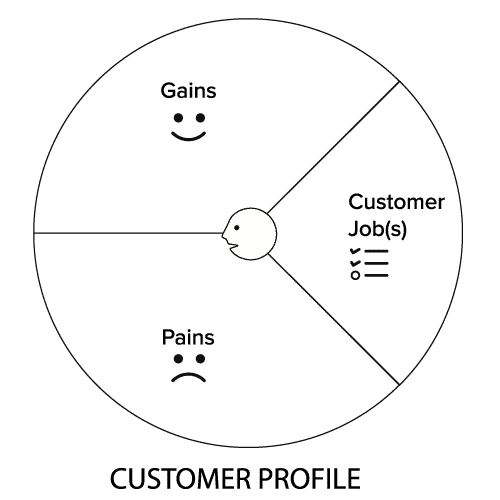
The principle is to use the Jobs To Be Done framework to create products or services that improve customers lives.
The Value Map
- Products and Services: A list of what you offer and may consist of service, product or both.
- Gain Creators: How your product or service creates customers gains – outcomes and benefits your customers expect.
- Pain Relievers: How you eliminate the things that annoy your customers.
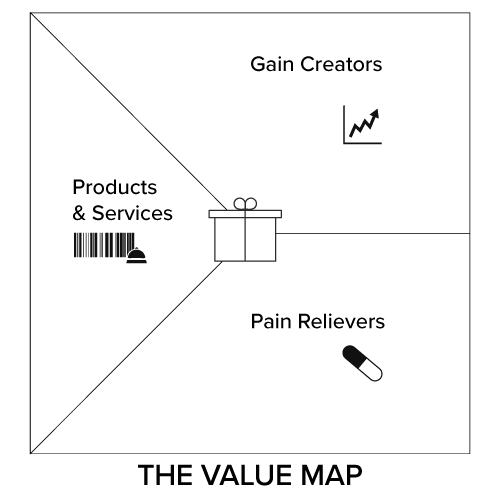
Achieving Fit
The fit is achieved when your customer recognizes your value proposition and takes action. The goal of the process is to test and refine your value proposition until you get fit across three stages:
- Problem-solution fit: Is achieved when you have evidence of the jobs, pains and gains that customers care about. At this stage, you are developing the value proposition and validating your ideas.
- Product-market fit: Is achieved when you test your solution in the market and get traction of your value proposition directly with customers. Often this isn’t a perfect fit and you will need to pivot and refine your value proposition to improve product-market fit.
- Business Model Fit: Is achieved when you design how a business is organized (resources, activities, partners) to create a profitable (revenue model) business model that is scalable.
How To Use The Value Proposition Canvas
In this section, I’ll walk you through how to use the Value Proposition Canvas and give you some pointers.
A good idea is to play with your ideas and write them down using the canvas.
Download the templates and fill them in. Print off a few copies and don’t aim for perfection first time round.
The more you become comfortable with it, the better you will get at crafting your value propositions.
Throughout this article, there are more resources to help you get the best out of the value proposition canvas.
Step 1. Jobs To Be Done
The Jobs To Be Done (JBTD) framework is a game-changer. It reframes how you think about your customers.
Even though this has been around for a while, it is still often new to organizations. The JBTD framework can be applied to:
- Strategy: Aligning your vision and mission with customers, finding gaps and opportunities in markets to invest in.
- Products or Services: Know what to build, plus the experiential and functional qualities it should have to meet customers needs.
- Marketing: Reinventing the customer experience, getting greater traction with existing customers, and improving retention rates.
JTBD isn’t a process or method it is a concept and as such there are different ideas and approaches in the real world. The two approaches you will come across are:
- Clayton Christensen and Alan Klement focus on the idea of progress and desires – often at a high-level that a customer wants to achieve.
- Tony Ulwick of Strategyn combines some of the high-level thinking with more task-orientated processes.
Personally, I recommend starting with a higher level and then working through to lower-level jobs.
customer jobs examples
- Booking a holiday for the family.
- Choosing a new car.
- Eating at a restaurant.
- Attending an event.
- Applying for a new job.
- Learning a new skill.
- Trying to get fit.
- Buying clothes.
As a rule, there are several universal jobs in every market. Even in B2B markets, the value proposition canvas is equally valuable as a tool.
How To Identify JTBD?
Consider these three types of jobs: Functional, Social and Emotional
- Functional jobs are practical considerations, usually quite mundane and straightforward.
- Social jobs are driven by a sense of duty, optimism, fear or aspiration. How we want to be seen, our fear of embarrassment and how we want to be valued in different roles.
- Emotional jobs come from our preferences, likes and dislikes, insecurities and indulgences.
When you research ‘jobs to be done’, there are a three things to consider that affect the outcome:
- The context: who, what, where, when e.g. ordering a table at a restaurant for a night out with your partner vs a table at the restaurant to entertain your new boss.
- Observations: past decisions, solutions and behaviours.
- Situational analysis: the ‘why’ – the pushes, pulls and anxieties.
Normally when teams think of value they move from features to benefits.
The problem with this approach is that it is linear, it doesn’t include the context of why people would see that as a benefit in different situations.
To compete in the hectic noise of media communications, against a deluge of messages, you have to demonstrate you understand the customer – benefits alone doesn’t work.
- Needs are functional. Wants are emotional.
- Needs have utility. Wants have energy.
Questions to help trigger Help Frame Your Customer Jobs
- Which job is the customer hiring a potential product for?
- What are the context and situation?
- What are the customer’s needs for every step of the job?
- What is the customer trying to improve?
- What else is the customer trying to thing about?
- What part of the consumption chain does customer cover?
So how do you actually go about understanding a customer’s JTBD?
How to start
The value proposition canvas is not a one-off exercise. One workshop is not a solution just a starting point. Embed the principles into your business and way of working. This will create a culture of exploration, a mindset to understand the customer through the JBTD lens.
a. with The Customer
- Wildly going on a hunt to identify jobs is like going on a safari without a map. Create the map first, what are your business priorities – where do you need to innovate – where is the focus. This will depend on the business strategy, market and customer profile. Once you know where you need to focus you can then work on the customer segment(s)- Who.
- Pool your existing research and data. Examine what data you have. What can be used? What offers you some initial insights and what can be discarded for now. Interviews or surveys are often a rich opportunity as a start point. What you know so far.
- Customer service: customer service is another opportunity to identify existing problems. Talk to your customer service department and make notes on common themes and feedback. Inevitably there are some nuggets to be found.
- Mind the gaps: In the long term use a mix of the following research methods (dependent on your budget and resource):
- One-to-one depth interviews.
- ethnography.
- focus groups.
- call centre listening.
- and even well-crafted quantitative surveys.
B. With Triggers
Bonus Tool 1: Another way to start is to use the empathy canvas. The canvas is designed to help you understand customer jobs and associated experiences.
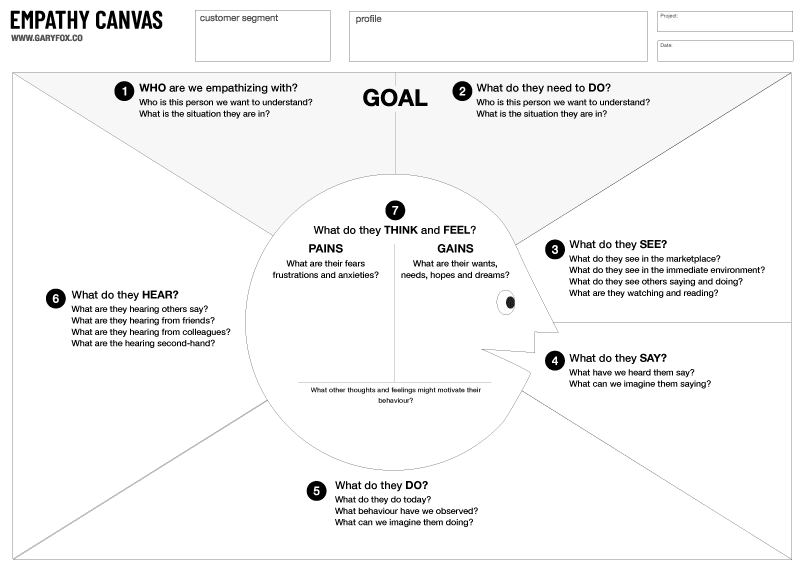
Alexander Osterwalder encourages people to also start without the customer! I personally recommend this as well.
Why? Because it quickly develops a customer-centric culture and starts the conversations within and across teams. Use ‘triggers’ to encourage people to question how things are done vs how things could be done. These are times for experimenting, not relying on knowledge that rapidly becomes dated and irrelevant.
The value proposition canvas and the business model canvas are both approaches that help to instil a mindset of reinvention – not always radical. Incremental innovative steps push a business forward and help it to maintain relevance in a market and sustain the growth of products and services.
Use Triggers
Digital transformation projects often get caught up in the internal focus and cost arguments without understanding how and where the customer fits in.
Triggers are essentially a way to reframe how you think about creating value.
- Imitate a pioneering model from another sector or industry.
- Take a new technology and think about how it could be used to change how a job is done.
- Think about how new partnerships could help create a new value proposition or transform an existing one.
- imagine a new product or service.
- create a new pain reliever based on a customer profile.
- create a new gain creator based on a customer profile.
Action
On post-it notes write down the customer jobs. Initially in your team or own your own write down your ideas and then filter afterwards.
Outcomes
Remember the first stage of the value proposition canvas is to create the Product-Solution fit.
- List of jobs to be done.
- Plan for further research plan with methods, timing and data required.
Step 2. Gains
The difference between gain creators and pain relievers is that gains are motivational and emotionally driven – outcomes. Pains are process and function-driven – obstacles/frustrations.
Gains need to be described as tightly as possible. They need to be detailed. Imagine for a moment that you are repeating back to a customer a ‘gain’. Write it down so that they would clearly identify with it. Remove jargon and buzzwords.
Gains are harder than pains to find. You can observe a pain, an obstacle, but understanding why someone wants to achieve a goal, a job, requires you to dig a bit deeper. To walk in the shoes of your customer.
Use the Customer Profile section of the value proposition canvas. Write down on post-it notes customer gains and categorize them based on the following:
- Required gains: These are the minimum requirements that a customer expects from a product or service.
- Expected gains: This is the basics – what a product or service needs to achieve to be of value to a customer. As an example, TV’s that are slim, well-designed, offer high-definition and connect to the internet – the gain is that you can stream video from lots of sources. Remember that the basics are set within an industry or context not just by your organization.
- Desired gains: These are the gains that a customer would love, that they desire, that they can articulate.
- Unexpected gains: These are the true innovations that create new ways of doing things and delight a customer. As an example, the first cars that had ever had integrated sat navigation, the first touch screen smartphones, the first app for hiring a ride – Uber (see Uber Business Model).
Questions to Help With Customer Gains
- What savings would make your customer happy? Be specific in terms of an amount or a percentage.
- What quality levels do they expect?
- What features do they expect?
- What positive social outcome do they?
Outcome
- A list of gains that are detailed and classified by relevance.
Step 3. Pains
Pains often go unnoticed. People just accept that this how things are done – how we do things. But customers change and competitors prey on weaknesses in products or services. They then act and evolve the value in the market, the offer which in turn ets new customer expectations. Prior to Apple introducing the touch screen, no other smartphone manufacturer needed to include it. After that moment everyone raced to add a touch screen but by that time market share is lost.
However, don’t discard the post-it notes with minor pains. Instead, group them up and see they form a theme. I often find that aggregating them can create a multiplier effect – often because they are inter-related and can be solved together and hence make a big step change.
Action: write down on post-it notes pains, one per note. Then categorize them. Some pains are minor, and not substantial. Of course, you want to focus on the big pains the ones that cause the workarounds, the headaches.
Types of pains
- Undesired outcomes, problems and characteristics:
- Outcomes are results that are unexpected. As an example, you book a car in for routine service and then go to pick it up. At the reception, you are given a bill for three things that the auto shop claimed needed doing. However, they didn’t call you or explain why or if they needed doing immediately.
- Problems are frustrations and annoyances that crop up while you are trying to do something. As an example, you book a table at a restaurant for 7pm. Upon arrival, you are told that you will have to wait because all the tables are busy. Fifteen minutes later no one has updated you and you are still waiting.
- Characteristics are features that may not be appealing either visually or functionally clunky. Examples include poor designs, bad signposting in a store, fonts on a website that are too small to read, running at the gym is boring, driving to work is unproductive time….each context will be relevant to different people.
- Obstacles: These are things that prevent people from getting things done or slow them down. As an example, your signup to try a new marketing platform. However, you need to integrate with it with your CRM system. You find out that the platform doesn’t support your CRM and it doesn’t have other possible integration possibilities like webhooks or Zapier.
- Risks: These are fears that could result from using something or prevent a customer from trying or adopting a new product or service. As an example, the fear of having to know code often prevents people from ever creating their own website.
Bonus Tool 2: Use a customer journey map to find valuable insights into pains that customers experience.
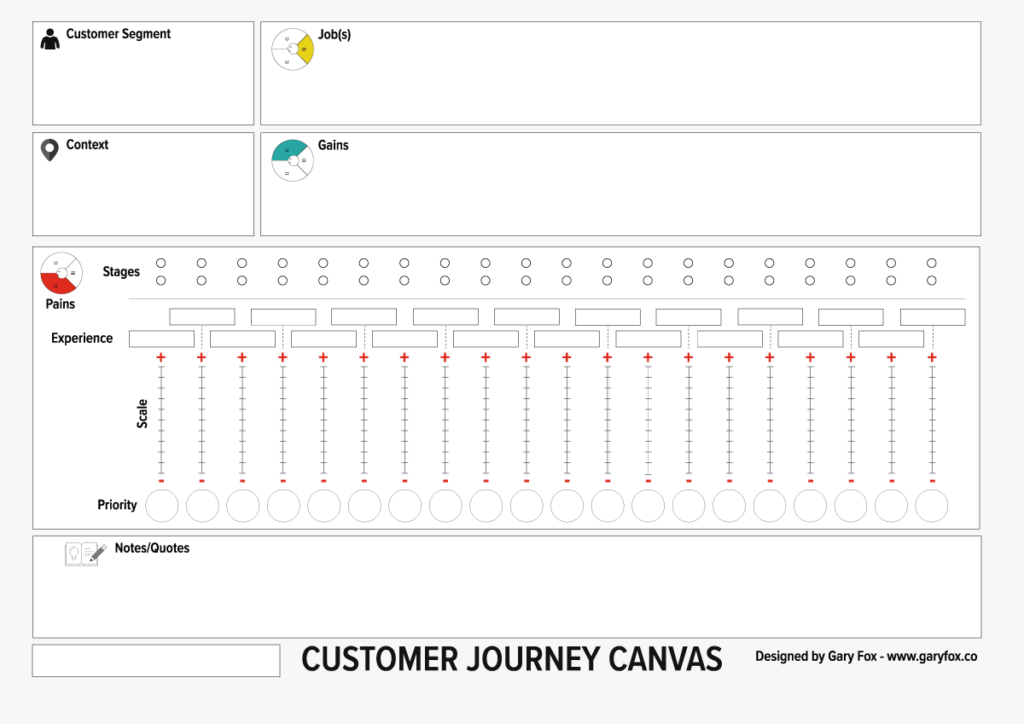
Pain Severity
List your pains and then rank them on the severity scale. Extreme equals the highest level of pain and moderate the lowest. It doesn’t have to exact, but get a think about how they compare to each other.
Outcome
- A list of pains ranked by severity.
Step 4. Prioritizing Jobs, Gains and Pains
Bonus Tool 3: The Value Proposition Canvas – Rank Map.
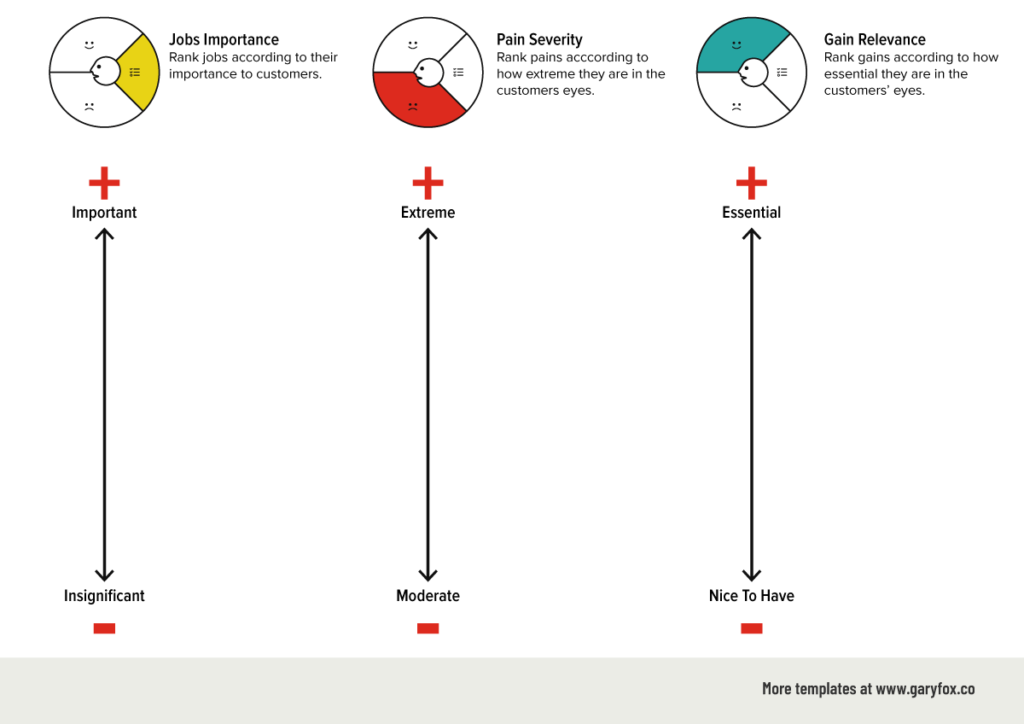
The canvas above is the standard canvas you can use to map your results. However, I prefer to use the canvas below (both are included in the free template pack).
For the one below, rank jobs first according to importance – 2 stars being most important and then plot them on the axis.
I always find that teams intuitively prefer using the 4 x 4 matrix below more.
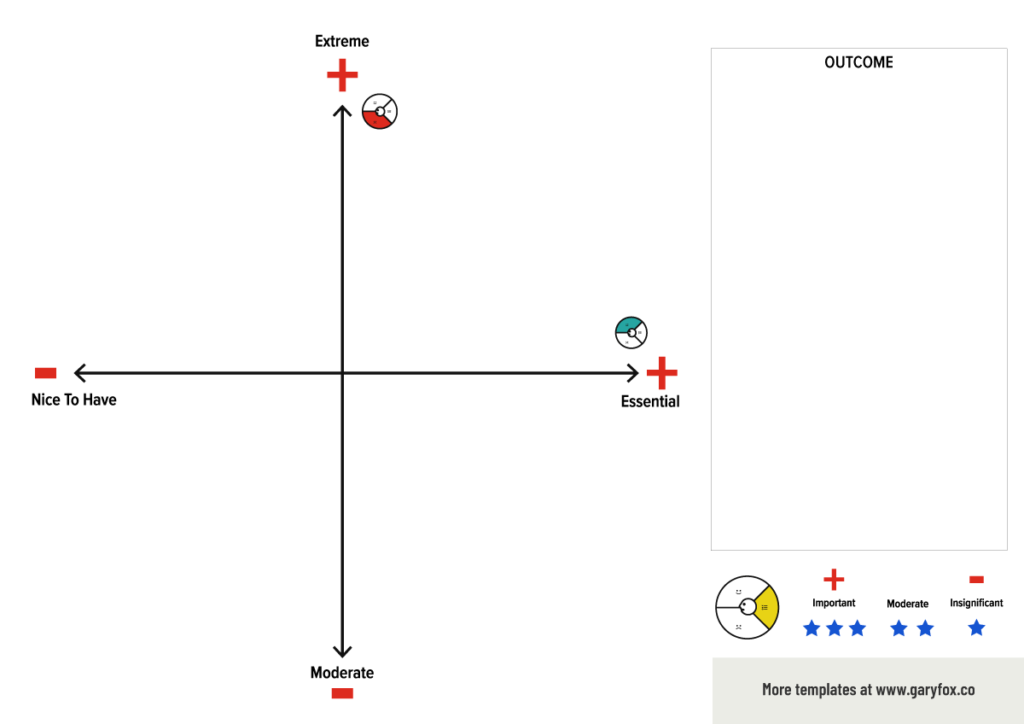
Outcome
- A list of the top gains and pains that are most important to a customer.
Step 5. Products and Services
The products and services part of the value proposition canvas is simply a list of what you offer.
Action: Place your post-it notes on the scale and move them up or down until you have them in order.
Depending on your product/service or business you want to focus on the top three to five.
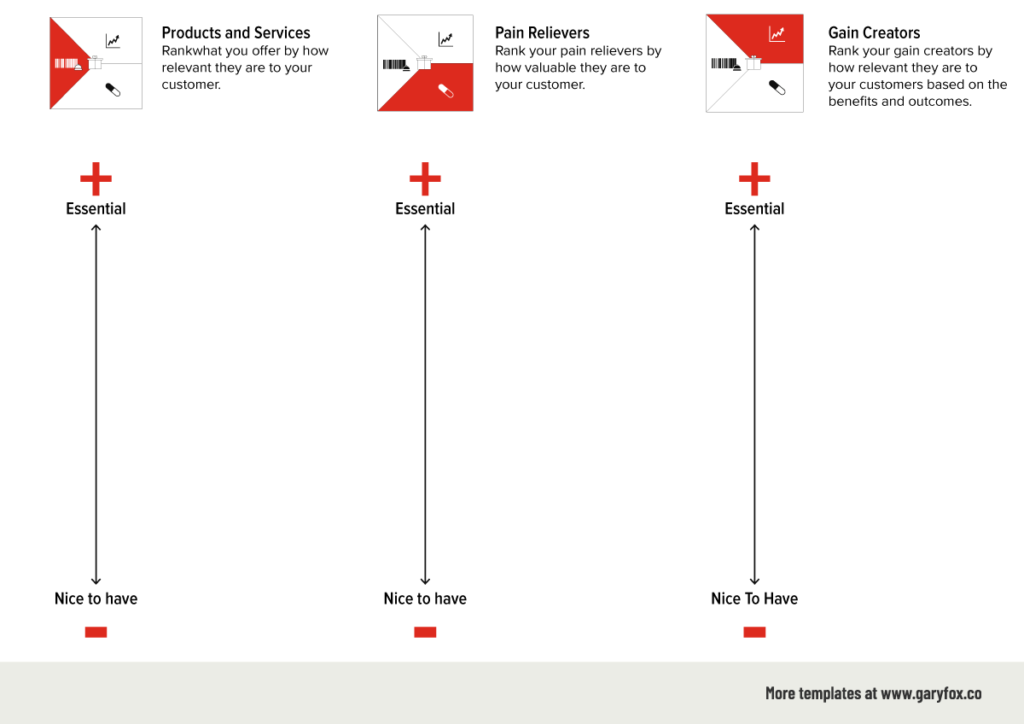
Products and services also should include the supporting services that you offer to customers e.g. 24/7 phone line or instant chat.
Types of products and services
- Physical/Tangible: Physical products that you sell e.g. hairdryer, jeans, car…
- Intangible: Services that support your product e.g. training, after-sales support.
- Digital: Products and/or services that are digital e.g. Software as a Service, music downloads, reports as digital files…
- Financial: Products such as investment funds, insurance…
Create a list of the most relevant and rank them based on their relevance: essential vs. nice to have.
Outcome
- A list of what your product or service offers ranked on the value proposition canvas value scale above.
Step 6. Pain Relievers
Pain Relievers describe how your products and services alleviate the pains you noted earlier.
The exciting part of going through this as a process is that it quickly opens up new ideas for how you can innovate your current offers.
Some useful questions to ask:
- Could your products or services produce savings? If so how?
- Make your customers feel better?
- Can you put an end to difficulties and challenges?
- Eliminate customers fears?
- Eliminate barriers that prevent customers from trying or adopting your product?
Outcome
- A list of ranked pain relievers from essential to nice to have.
Step 7. Gain Creators
The pain relievers part of the value proposition canvas describes how your products and services alleviate the pains you noted earlier.
Some useful questions.
Could your product or services:
- create savings that please your customers – money, time or effort?
- produce outcomes that exceed their expectations?
- outperform current value propositions?
- create positive social consequences?
- enhance the design and make it easier to use?
- help make adoption easier?
Outcome
A list of ranked gainer creators ranked from essential to nice to have.
Step 8. Mapping Fit
Bonus Tool 4: Mapping Fit Canvas
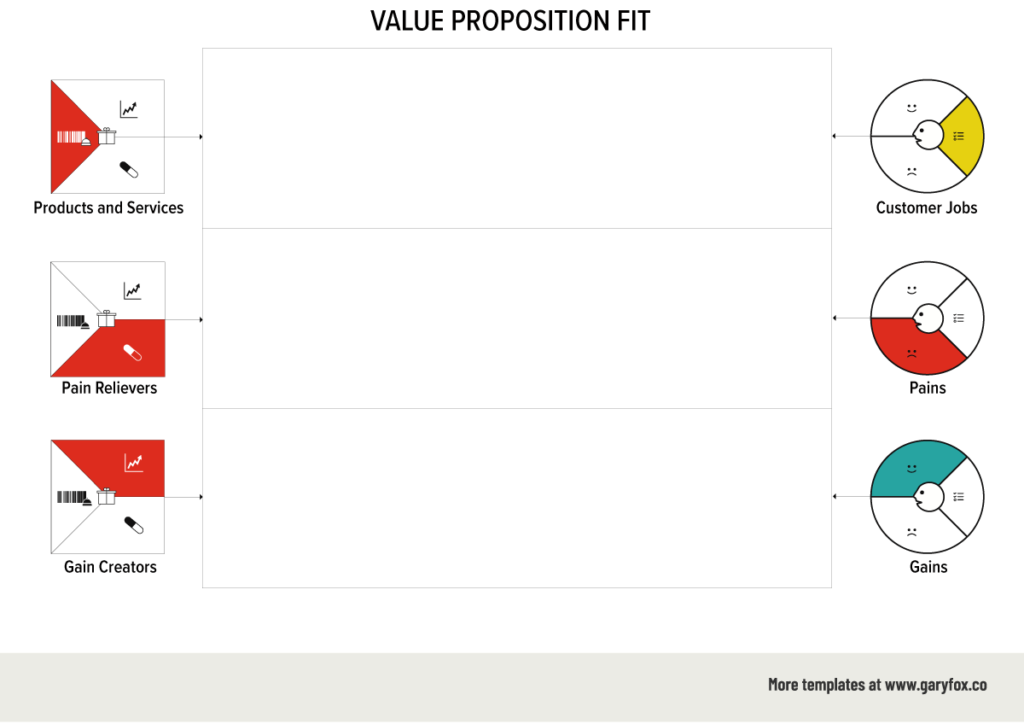
The last stage of the value proposition is to match pain relievers to pain and gain creators to gains.
Note: as a business, you can’t solve every pain. You ideally want to solve the pains and create gains that improve your offer, provide opportunities to increase the value or innovate.
Product Services and Customer Jobs Section
In the value proposition canvas above you have the top section with product/services and customers jobs.
Example question: Does our current products and services meet the required customer jobs? and how well?
Pains and Pain Relievers
Example questions:
- Which pain relievers do we currently offer – do they adequately address the customer pains?
- What do we need to do to create pain relievers that we do not currently have?
Outcome
At this stage, you’re mapping the opportunities for the value proposition. Check that you are addressing what matters to customers and the logic and connection across the parts.
Step 9. Ideate and Explore
Striving to achieve a succinct and clear value expression is the goal, but you might need to order them – have one clear statement and then supporting ones that reinforce the main one.
Value statement templates – Ad Libs
To distil your ideas and to reduce the clutter try using an ad-lib.
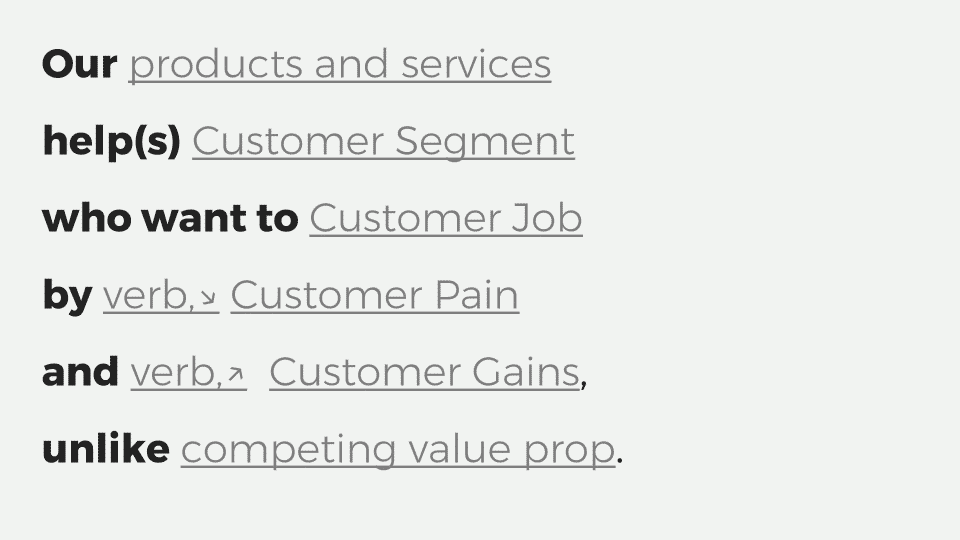
Sketch Ideas
You don’t have to be a designer to sketch ideas – simple diagrams/sketches no matter how you do them can ignite ideas and help move you forward.
A few guiding principles
Great value propositions have these characteristics:
- Focus on unsatisfied jobs, unresolved pains and unrealized gains.
- Target few jobs, pains and gains.
- Go beyond functional jobs and address social and emotional jobs.
- Align with how customers measure success.
- Differentiate themselves from the competition on jobs, pains and gains customers care about.
- Outperform the competition on at least one dimension.
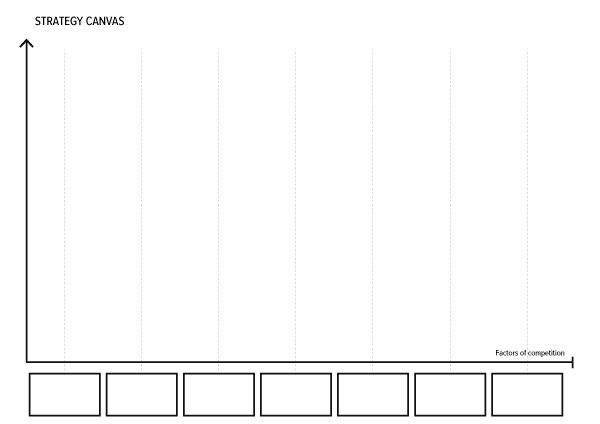
To see how your ideas shape up. List the value propositions along the x-axis on the strategy map and then map on the y-axis how your value proposition compares to 2-3 competitors.
Step 10. Test The Value Proposition
After finishing the value proposition canvas you are ready to move to test. I’ll cover this in a blog.
The best and easy way to test your value proposition is often to use it on a website with the product or service. As an example, there are a variety of AB testing tools that you can use. It can be as simple as trying different landing pages.
Summary and Some Key Points When Using The Value Proposition Canvas
If you run a workshop using the value proposition canvas, you will be amazed at the examples, insights and progress you make. The value proposition canvas is a tool that enables people to share a common mental model of the customer, how the business generates value and what possibilities exist to innovate.
Creating a value proposition is a method of clearly defining aspects of a product or service that a customer might need and why. It is a way of presenting inherent advantages that a competitor might not be able to offer and is therefore often referred to as a Unique Selling Point (USP).
A value proposition statement can be generated by using an ad-lib as part of the value proposition canvas guide,
- It’s important to realise that you won’t know if you have the right value proposition until you test it with customers. However, using this guide will help you to understand how to craft compelling value propositions.
- You will need different value propositions for different customer segments. Think deeply about how your segments differ in how, why and when they try and get jobs done.
- Once you think you have some insights then test them out. Use different methods to validate your ideas and insights.
- Developing a value using desktop only research and data doesn’t work. Too often a business will use what they about a customer as the basis for developing a product or service – that approach contributes to the massive failure rate of new products that still exists. Walk in the shoes of your customer, observe them, ask questions, be curious and test ideas.
Free Value proposition Canvas Templates Pdfs Downloads
The following value proposition canvas templates are included in this download:
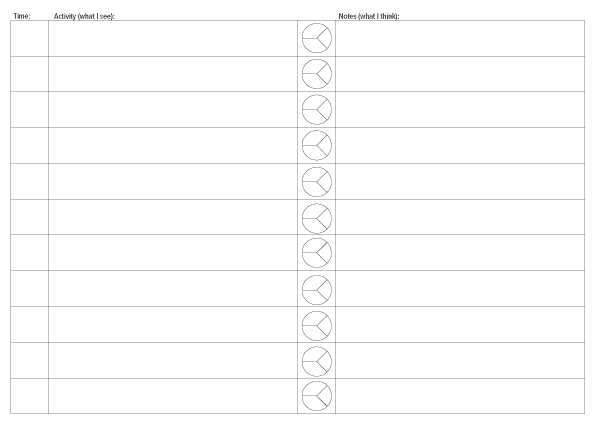

Get These Free Pdf Templates
- Value proposition canvas – main template.
- Value proposition scale – value map and customer profile.
- Value proposition matrix – value map and customer profile.
- Value proposition – a day in the Life template.
- The Empathy Map – pdf template
- The Customer Journey Map – pdf template
- The Strategy Map
Questions Or Help
If you have any questions or need any help with using the value proposition canvas then get in touch via the contact page.
Download Free Templates
DOWNLOAD FREE HIGH-QUALITY PRINTABLE PDF’s
Click to download free high-quality printable pdf’s of the Value Proposition Canvas.
width 3508 px x height 2480 px (300 dpi)
width 7016 px x height 4960 px (300 dpi)
width 14043 px x height 9933 px (300 dpi)
